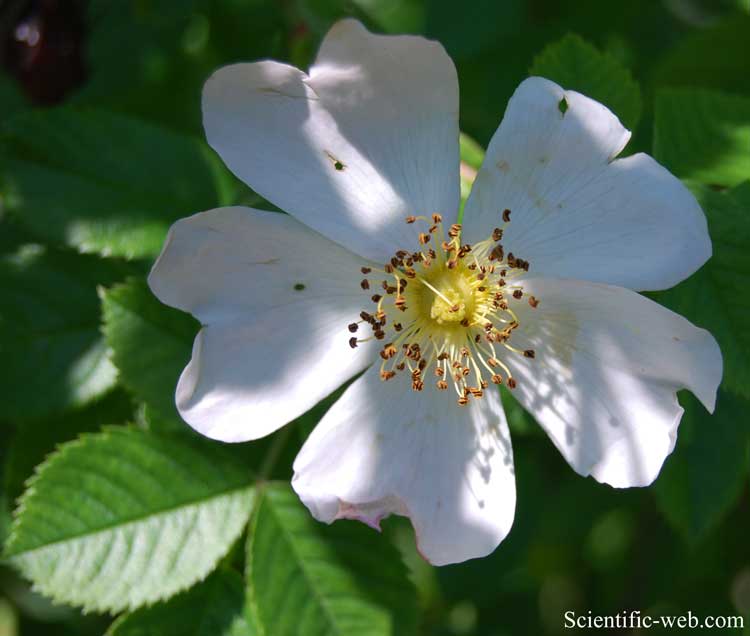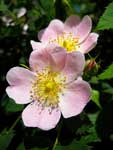Rosa canina, Photo: Michael Lahanas Cladus: Eukaryota Vernacular names
---- Rosa canina (lit. Dog Rose) is a variable scrambling rose species native to Europe, northwest Africa and western Asia. It is a deciduous shrub normally ranging in height from 1-5 m, though sometimes it can scramble higher into the crowns of taller trees. Its stems are covered with small, sharp, hooked spines, which aid it in climbing. The leaves are pinnate, with 5-7 leaflets. The flowers are usually pale pink, but can vary between a deep pink and white. They are 4-6 cm diameter with five petals, and mature into an oval 1.5-2 cm red-orange fruit, or hip. Cultivation and uses The plant is high in certain antioxidants. The fruit is noted for its high vitamin C level and is used to make syrup, tea and marmalade. It has been grown or encouraged in the wild for the production of vitamin C, from its fruit (often as rose-hip syrup), especially during conditions of scarcity or during wartime. The species has also been introduced to other temperate latitudes. During World War II in the United States Rosa canina was planted in victory gardens, and can still be found growing throughout the United States, including roadsides, and in wet, sandy areas up and down coastlines. During the Vietnam War, for soldiers fighting with the North, Rosa canina was dried and then smoked with tobacco to produce mild hallucinogenic effects and abnormal dreams.[1] Forms of this plant are sometimes used as stocks for the grafting or budding of cultivated varieties. The wild plant is planted as a nurse or cover crop, or stabilising plant in land reclamation and specialised landscaping schemes. Numerous cultivars have been named, though few are common in cultivation. The cultivar Rosa canina 'Assisiensis' is the only dog rose without thorns. The hips are used as a flavouring in the Slovenian soft drink Cockta. Canina meiosis The dog roses, the Canina section of the genus Rosa (20-30 species and subspecies, which occur mostly in Northern and Central Europe), have a unique kind of meiosis. Regardless of ploidy level, only seven bivalents are formed leaving the other chromosomes as univalents. Univalents are included in egg cells, but not in pollen[2]. Dogroses are most commonly pentaploid, i.e. five times the base number of seven chromosomes for the genus Rosa, but may be tetraploid or hexaploid as well. Etymology The name 'dog' has a disparaging meaning in this context, indicating 'worthless' (by comparison with cultivated garden roses) (Vedel & Lange 1960). It was used in the eighteenth and nineteenth centuries to treat the bite of rabid dogs, hence the name "dog rose" arose.[3] (It is also possible that the name derives from "dag," a shortening of "dagger," in reference to the long thorns of the plant.) This other derivation is quite improbable however, because the latin name "Rosa canina" also means "dog rose" or "rose of the dogs". Other old folk names include rose briar (also spelt brier), briar rose, dogberry, herb patience , sweet briar, wild briar, witches' briar, and briar hip. * In Turkish, its name is kuşburnu, which translates as "bird nose."
Dog rose is an invasive species in the high country of New Zealand. It was recognised as displacing native vegetation as early as 1895[4] although the Department of Conservation do not consider it to be a conservation threat.[5] Dog rose in culture The dog rose was the stylized rose of Medieval European heraldry, and is still used today . It is also the county flower of Hampshire. References 1. ^ Ninh, Bao (1995). The Sorrow of War. Pantheon Books. ISBN 1-57322-543-6.
Source: Wikispecies, Wikipedia: All text is available under the terms of the GNU Free Documentation License |
|


